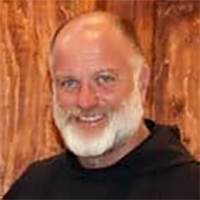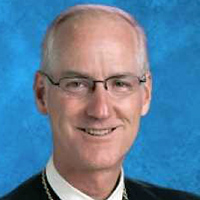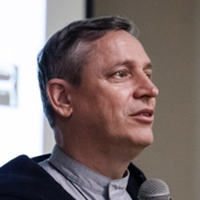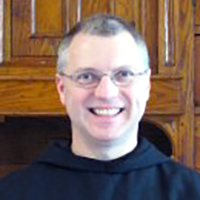4 Religious Reflect on Their Communities and Vocations
“It’s been wonderful, giving myself to something much greater than myself.”

The renewal of religious life is a topic of regular conversation in Catholic circles. I spoke with four men in religious life, two priests and two brothers, about their vocations and communities. Three of the four I spoke to serve in leadership roles. The communities vary in size, are located in different regions of the country and are committed to a different work. However, all are faithful to the teaching authority of the Church, wear religious clothing, live together and share a common prayer life.

The monastery is located in a beautiful setting 75 miles north of Santa Fe. The beautiful scenery along the way includes rock formations, high cliffs, mesas, tree-covered mountains and the Chama River in the center of the valley. The nearest town of 300 is a 45-minute drive away.
The monastery is home to 60 monks who wear the traditional Benedictine habit and follow the Rule of St. Benedict. They begin their day with prayer at 4 a.m. and all prayers are sung. They practice a life of penance — for example, they do not eat meat.
The monastery was founded in 1964, and offers minimal luxuries. The guest house, for example, didn’t get electricity until 2014. About 30,000 visit the community each year. Its popularity and success, Fr. Benedict believes, is because “We’re a joyful community, and joy is very attractive. We’ve had the same superior for 42 years, which leads to stability and continuity. And, we’re faithful to the monastic tradition and the teaching of the Church, and fidelity is important.”
Fr. Benedict has been a monk for 41 years. He said, “If you’re not called to this life, you’ll find it difficult. We have ‘short sleep and long prayer.’ But for those called to it, it is heaven. It is unbelievably beautiful.”

The monks wear a traditional Cistercian habit, a white tunic with a black scapular. Their principal work is teaching at a prep school for boys grades 5-12. They also teach at the University of Dallas, and help out in local parishes.
Fr. Verhalen was first exposed to the community in 1964, when he attended the prep school as a student. He attended for nine years, and entered the monastery after his sophomore year in college. He said, “I’ve been very grateful for my vocation. It’s been a beautiful life.”
After some lean years, the community has more recently being doing well for vocations, with five men in formation and an average age of 37. Fr. Verhalen said, “It is grace, and the fruit of the work of our previous abbot, Fr. Denis Farkasfalvy. Beginning in 2003, we had three guys come each of five years in a row. They were excellent young men, happy and healthy, and of the 15, 11 persevered to ordination. When young men discerning a vocation come to us, they see other young men in the community who are talented, athletic and pious, and they want to join. It’s been a snowball effect.”
Father recently traveled to Hungary for beatification of Fr. János Brenner (1931-57), a Hungarian Cistercian priest and martyr. Fr. Brenner is the first member in the history of the community to be beatified. Fr. Verhalen said the priest has “a beautiful story.” He continued, “He’s a role model for us; I keep a picture of him in my office. He was a young man living in terrible circumstances, but like many other Cistercians who remained in the country, maintained a joy in life. So, I went in support of our Hungarian Cistercians, and because of my devotion to Fr. Brenner.”
Among his most cherished memories of his visit was when Fr. János’ brother, Fr. Joseph Brenner, who is a diocesan priest in his 80s, placed his brother’s relics in a reliquary next to the altar. Fr. Verhalen said, “So, you had the altar, where the sacrifice of Christ was about to be made present, next to the bones of a man who had sacrificed his life for Christ.”
Later, Fr. Joseph, who was one of the main concelebrants, inserted the name of his brother into the canon of the Mass. Father said, “You could tell Fr. Joseph was moved; his voice was quivering.”

Brother Ken is from the Bronx in New York City. While attending Rutgers University in New Jersey, he met the brothers, who had just begun doing campus ministry. He went on retreat with them, and his life was changed. He said, “I had been Catholic, but never had a personal encounter with the Lord. I had faith that God existed, but He was not part of my life.”
He was also impressed with the quality of men who were joining the Brotherhood of Hope. The community’s founder, Fr. Philip Merdinger, he continued, “had clear conviction and insight into collapse of celibacy in the Church … in our sex-crazed age, lifelong religious celibacy had become an absurdity to many people.”
Brother Ken calls the vocation to become a brother a “disappearing vocation,” and believes that “the Lord is using the Brotherhood of Hope to bring about a religious renewal.”
Brother Ken and his fellow brothers follow a “daily rhythm of prayer,” which includes an hour of adoration. They then head out to their assigned college campuses, meeting and working with students. Many have been receptive to the brothers’ message, he said, “discovering God’s love, with many moving on to become leaders in the Church.”

Brother Ezekiel grew up in the Chicago area, and moved to New York to pursue an acting career. Although he was raised Catholic, he left the Church for a time, but returned when he was in his 30s. He loves to sing, and recalled during his “reversion” to the Church how he sang for a time in a Presbyterian church choir. He said, “I stood out with my long hair, but I was right at home with the Brahms and Beethoven music we sang.”
He read Thomas Merton’s The Seven Storey Mountain, he decided he wanted to enter religious life. Because of his age and some personal challenges, he had difficulty finding a community that would accept him. He finally applied and was accepted at the Monastery of the Holy Cross, a Benedictine community on the South Side of Chicago. The community is dedicated to prayer, and sustains itself by operating a bed & breakfast.
Brother Ezekiel lives the Benedictine motto ora et labora (“pray and work”). He rises to pray at 3:30 a.m., and devotes several hours a day to prayer. His manual labor includes caring for the grounds of the community. He admitted it was hard to submit to the will of a superior: “Your dreams are not your own. You may want to do one thing with your life, but you must give over your will to what the community wants.”
But Brother Ezekiel is happy with his home in the community: “I was ready for a life of study and prayer. I wasn’t happy with my life outside. It’s been wonderful, giving myself to something much greater than myself.”












